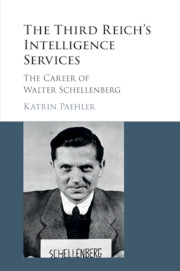Book contents
- Frontmatter
- Dedication
- Contents
- List of Figures
- Acknowledgments
- Archives
- Introduction
- 1 Gaining a Foothold
- 2 Rising Star
- 3 Intelligence Man
- 4 Office VI and Its Forerunner
- 5 Competing Visions: Office VI and the Abwehr
- 6 Doing Intelligence: Italy as an Example
- 7 Alternative Universes: Office VI and the Auswärtige Amt
- 8 Schellenberg, Himmler, and the Quest for “Peace”
- 9 Postwar
- 10 Concluding Thoughts
- Appendix
- Glossary
- Index
Introduction
Published online by Cambridge University Press: 31 March 2017
- Frontmatter
- Dedication
- Contents
- List of Figures
- Acknowledgments
- Archives
- Introduction
- 1 Gaining a Foothold
- 2 Rising Star
- 3 Intelligence Man
- 4 Office VI and Its Forerunner
- 5 Competing Visions: Office VI and the Abwehr
- 6 Doing Intelligence: Italy as an Example
- 7 Alternative Universes: Office VI and the Auswärtige Amt
- 8 Schellenberg, Himmler, and the Quest for “Peace”
- 9 Postwar
- 10 Concluding Thoughts
- Appendix
- Glossary
- Index
Summary
Schellenberg's name was known to have received a certain prominence in the World Press, not only because of the important position in the G.I.S. [German Intelligence Service], that he held during the greater part of the war, but also on account of the leading part he had played in certain peace negotiations.
Final Report on the Case of Walter SchellenbergIntelligence combines information and understanding. In spring 1952, an unexpected piece of information rippled through the international postwar intelligence community: Walter Schellenberg, the head of Nazi Germany's political foreign intelligence service, Amt VI of Heinrich Himmler's Reichssicherheitshauptamt (RSHA) – Office VI of the Reich Security Main Office – and advisor to and confidant of Himmler had died in Italy. A flurry of intelligence activity took place, meant to confirm a death that despite the man's longstanding ailments came as a surprise. An understanding and appreciation of the facts settled in soon. There would be no further need by the various intelligence services to concern themselves with the former spymaster.
Walter Schellenberg's career had been illustrious. Born in 1910, he was fresh out of law school when Adolf Hitler was appointed chancellor on January 30, 1933. Quickly aligning himself with the new government, Schellenberg joined the NSDAP and SS, Schutzstaffel – Protective Squads – and was shortly thereafter recruited into the SD, Sicherheitsdienst – Security and Intelligence Service – of the SS. Over the course of the next decade, Schellenberg, taking all opportunities given to him and creating additional ones along the way, made a stellar career that brought him close to the head of the SD, Reinhard Heydrich and Himmler. In the summer of 1941, Walter Schellenberg was appointed to lead Office VI, the political foreign intelligence service, of Heinrich Himmler's main instrument of power and terror, the RSHA. Having headed the Gestapo's counterintelligence department in the two years prior to this, Schellenberg was no stranger to intelligence matters.
- Type
- Chapter
- Information
- The Third Reich's Intelligence ServicesThe Career of Walter Schellenberg, pp. 1 - 22Publisher: Cambridge University PressPrint publication year: 2017

